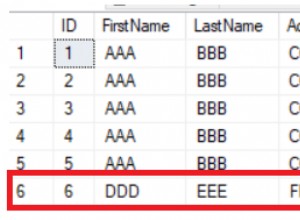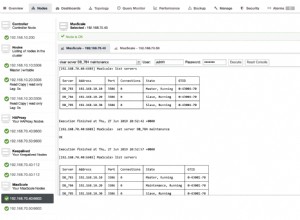Solução
Eu realmente não sei como transformar uma lista horizontal de valores separados por vírgula em uma lista de linhas sem criar uma tabela contendo números, tantos números quantos você possa ter valores separados por vírgula. Se você pode criar esta tabela, aqui está minha resposta:
SELECT
SUBSTRING_INDEX(SUBSTRING_INDEX(all_tags, ',', num), ',', -1) AS one_tag,
COUNT(*) AS cnt
FROM (
SELECT
GROUP_CONCAT(tags separator ',') AS all_tags,
LENGTH(GROUP_CONCAT(tags SEPARATOR ',')) - LENGTH(REPLACE(GROUP_CONCAT(tags SEPARATOR ','), ',', '')) + 1 AS count_tags
FROM test
) t
JOIN numbers n
ON n.num <= t.count_tags
GROUP BY one_tag
ORDER BY cnt DESC;
Devoluções:
+---------------------+-----+
| one_tag | cnt |
+---------------------+-----+
| chicken | 5 |
| pork | 4 |
| spaghetti | 3 |
| fried-rice | 2 |
| manchurain | 2 |
| pho | 1 |
| chicken-calzone | 1 |
| fettuccine | 1 |
| chorizo | 1 |
| meat-balls | 1 |
| miso-soup | 1 |
| chanko-nabe | 1 |
| chicken-manchurian | 1 |
| pork-manchurian | 1 |
| sweet-and-sour-pork | 1 |
| peking-duck | 1 |
| duck | 1 |
+---------------------+-----+
17 rows in set (0.01 sec)
Veja sqlfiddle
Explicação
Cenário
- Concatenamos todas as tags usando uma vírgula para criar apenas uma lista de tags em vez de uma por linha
- Contamos quantas tags temos em nossa lista
- Descobrimos como podemos obter um valor nesta lista
- Descobrimos como podemos obter todos os valores como linhas distintas
- Contamos as tags agrupadas por seu valor
Contexto
Vamos construir seu esquema:
CREATE TABLE test (
id INT PRIMARY KEY,
tags VARCHAR(255)
);
INSERT INTO test VALUES
("1", "pho,pork"),
("2", "fried-rice,chicken"),
("3", "fried-rice,pork"),
("4", "chicken-calzone,chicken"),
("5", "fettuccine,chicken"),
("6", "spaghetti,chicken"),
("7", "spaghetti,chorizo"),
("8", "spaghetti,meat-balls"),
("9", "miso-soup"),
("10", "chanko-nabe"),
("11", "chicken-manchurian,chicken,manchurain"),
("12", "pork-manchurian,pork,manchurain"),
("13", "sweet-and-sour-pork,pork"),
("14", "peking-duck,duck");
Concatenar toda a lista de tags
Trabalharemos com todas as tags em uma única linha, então usamos
GROUP_CONCAT para fazer o trabalho:SELECT GROUP_CONCAT(tags SEPARATOR ',') FROM test;
Retorna todas as tags separadas por vírgula:
Contar todas as tags
Para contar todas as tags, obtemos o comprimento da lista completa de tags e removemos o comprimento da lista completa de tags após substituir o
, por nada. Adicionamos 1, pois o separador está entre dois valores. SELECT LENGTH(GROUP_CONCAT(tags SEPARATOR ',')) - LENGTH(REPLACE(GROUP_CONCAT(tags SEPARATOR ','), ',', '')) + 1 AS count_tags
FROM test;
Devoluções:
+------------+
| count_tags |
+------------+
| 28 |
+------------+
1 row in set (0.00 sec)
Obter a enésima tag na lista de tags
Usamos o
SUBSTRING_INDEX função para obter -- returns the string until the 2nd delimiter\'s occurrence from left to right: a,b
SELECT SUBSTRING_INDEX('a,b,c', ',', 2);
-- return the string until the 1st delimiter, from right to left: c
SELECT SUBSTRING_INDEX('a,b,c', ',', -1);
-- we need both to get: b (with 2 being the tag number)
SELECT SUBSTRING_INDEX(SUBSTRING_INDEX('a,b,c', ',', 2), ',', -1);
Com essa lógica, para obter a 3ª tag da nossa lista, usamos:
SELECT SUBSTRING_INDEX(SUBSTRING_INDEX(GROUP_CONCAT(tags SEPARATOR ','), ',', 3), ',', -1)
FROM test;
Devoluções:
+-------------------------------------------------------------------------------------+
| SUBSTRING_INDEX(SUBSTRING_INDEX(GROUP_CONCAT(tags SEPARATOR ','), ',', 3), ',', -1) |
+-------------------------------------------------------------------------------------+
| fried-rice |
+-------------------------------------------------------------------------------------+
1 row in set (0.00 sec)
Obter todos os valores como linhas distintas
Minha ideia é um pouco complicada:
- Sei que podemos criar linhas juntando tabelas
- Preciso obter a enésima tag na lista usando a solicitação acima
Então vamos criar uma tabela contendo todos os números de 1 até o número máximo de tags que você pode ter na sua lista. Se você puder ter valores de 1 milhão, crie entradas de 1 milhão de 1 a 1.000.000. Para 100 tags, isso será:
CREATE TABLE numbers (
num INT PRIMARY KEY
);
INSERT INTO numbers VALUES
( 1 ), ( 2 ), ( 3 ), ( 4 ), ( 5 ), ( 6 ), ( 7 ), ( 8 ), ( 9 ), ( 10 ),
( 11 ), ( 12 ), ( 13 ), ( 14 ), ( 15 ), ( 16 ), ( 17 ), ( 18 ), ( 19 ), ( 20 ),
( 21 ), ( 22 ), ( 23 ), ( 24 ), ( 25 ), ( 26 ), ( 27 ), ( 28 ), ( 29 ), ( 30 ),
( 31 ), ( 32 ), ( 33 ), ( 34 ), ( 35 ), ( 36 ), ( 37 ), ( 38 ), ( 39 ), ( 40 ),
( 41 ), ( 42 ), ( 43 ), ( 44 ), ( 45 ), ( 46 ), ( 47 ), ( 48 ), ( 49 ), ( 50 ),
( 51 ), ( 52 ), ( 53 ), ( 54 ), ( 55 ), ( 56 ), ( 57 ), ( 58 ), ( 59 ), ( 60 ),
( 61 ), ( 62 ), ( 63 ), ( 64 ), ( 65 ), ( 66 ), ( 67 ), ( 68 ), ( 69 ), ( 70 ),
( 71 ), ( 72 ), ( 73 ), ( 74 ), ( 75 ), ( 76 ), ( 77 ), ( 78 ), ( 79 ), ( 80 ),
( 81 ), ( 82 ), ( 83 ), ( 84 ), ( 85 ), ( 86 ), ( 87 ), ( 88 ), ( 89 ), ( 90 ),
( 91 ), ( 92 ), ( 93 ), ( 94 ), ( 95 ), ( 96 ), ( 97 ), ( 98 ), ( 99 ), ( 100 );
Agora, obtemos o
num th (num sendo uma linha em number ) usando a seguinte consulta:SELECT n.num, SUBSTRING_INDEX(SUBSTRING_INDEX(all_tags, ',', num), ',', -1) as one_tag
FROM (
SELECT
GROUP_CONCAT(tags SEPARATOR ',') AS all_tags,
LENGTH(GROUP_CONCAT(tags SEPARATOR ',')) - LENGTH(REPLACE(GROUP_CONCAT(tags SEPARATOR ','), ',', '')) + 1 AS count_tags
FROM test
) t
JOIN numbers n
ON n.num <= t.count_tags
Devoluções:
+-----+---------------------+
| num | one_tag |
+-----+---------------------+
| 1 | pho |
| 2 | pork |
| 3 | fried-rice |
| 4 | chicken |
| 5 | fried-rice |
| 6 | pork |
| 7 | chicken-calzone |
| 8 | chicken |
| 9 | fettuccine |
| 10 | chicken |
| 11 | spaghetti |
| 12 | chicken |
| 13 | spaghetti |
| 14 | chorizo |
| 15 | spaghetti |
| 16 | meat-balls |
| 17 | miso-soup |
| 18 | chanko-nabe |
| 19 | chicken-manchurian |
| 20 | chicken |
| 21 | manchurain |
| 22 | pork-manchurian |
| 23 | pork |
| 24 | manchurain |
| 25 | sweet-and-sour-pork |
| 26 | pork |
| 27 | peking-duck |
| 28 | duck |
+-----+---------------------+
28 rows in set (0.01 sec)
Contar ocorrências de tags
Assim que tivermos o clássico linhas, podemos contar facilmente as ocorrências de cada tag.
Veja o parte superior desta resposta para ver o pedido.




